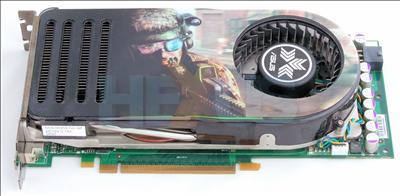Card appearance and thoughts
Visually-speaking, ASUS' effort is identical to any other GeForce 8800 GTS 320. Reading between the lines, it's a pure reference design, as approved by NVIDIA.
That entails a quiet fan on a cooler that takes up two slots' worth of room. The PCB is large, sure, but should fit into most chassis, supporting ATX-sized motherboards, without any problems.
Very much in the vein of its 640MiB-equipped brother, which only differs with respect to framebuffer size, the 320MiB SKU has core/shader/memory clocks of 513MHz/1188MHz/1584MHz, respectively. That, then, makes it a little faster on the core and a little slower on shader and memory than a reference model, nominally clocked in at 500/1200/1600.
The GTS variants don't require quite as much power as the range-topping Ultra and GTX SKUs, and that's physically manifested in the provision of a single 6-pin PCIe auxillary power connector.
We'd recommend a quality 400W-500W PSU as a minimum, assuming your other PC components are mid-to-high-end, too.
Heat transferred from the GPU and memories is pushed out of the rear through the vents you see above. The pushing, obviously, is done by the large, slow-spinning radial fan.
Both DVI ports are dual-link, which means they can run ultra-high-resolution displays such as the Dell 3007WFP at its native 2560x1600.
NVIDIA, and by extension ASUS, has endowed the GeForce 8800 GTS 320 with HDCP compatibility. What that translates to in a real-world sense is the ability to playback protected high-def content - Blu-ray and HD-DVD being prime examples - in its full glory.
Please note, though, that the HDCP magic is able to output via single-link only. Coming back to the WQXGA-capable Dell 3007WFP, resolution will be 'limited' to 1280x800. Newer 8-series GPUs and AMD's entire line of Radeon HDs offer dual-link HDCP, if that matters to you.
The rear is wonderfully unspectacular. The card's 320MiB GDDR3 memories are contained on the topside. NVIDIA, of course, enables the '320 with multi-GPU SLI connectivity, and you can see the requisite golden finger on the top-right.
Summary
There's not much new we can say on a card based upon a proven reference design. ASUS has toggled the key default frequencies a touch, gaining a little extra pixel-pushing power but losing a modicum of shading and bandwidth clout.Let's now see if the bundle can differentiate the EN8800GTS/HTDP/320 from the crowd of similar offerings from its competitors.














